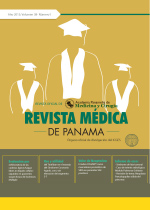Experiencia En El Manejo De Los Pacientes Con Melanoma En El Instituto Oncológico Nacional De Panamá En Los Años 2012 Al 2017.

Autores/as
DOI:
https://doi.org/10.37980/im.journal.rmdp.2019797Resumen
[Experience In The Management Of Patients With Melanoma In The National Oncology Institute Of Panama In The Years 2012 To 2017.]
Resumen
Introducción: A nivel mundial hay un incremento de la incidencia de melanoma, Panamá no escapa a esta realidad. Para todas las etapas hay riesgo de recurrencia inclusive luego de una cirugía adecuada y elevadas probabilidades de fallecer a causa de metástasis. Este trabajo busca conocer la experiencia del ION en el tratamiento de estos pacientes, la cual no ha sido publicada a la fecha. Objetivos: Describir las características de los pacientes con melanoma y determinar la Supervivencia Global (OS) y la Supervivencia Libre de Recurrencia (RFS). Metodología: Estudio retrospectivo de los pacientes con melanoma referidos al ION en los años 2012 a 2017 y el análisis de OS y RFS por el método de Kaplan-Meier. Resultados: Un total de 247 pacientes de melanoma fueron atendidos en el ION en el periodo del estudio; 51.8% eran masculinos con mediana de edad de 65 años. El sitio más común fue acral (31%). En total 46% de nuestros pacientes están en etapas III-IV. Un 65% del total fueron operados, de éstos 80% con resección amplia, 27% con evaluaciones de ganglio centinela y 25% linfadenectomías. Encontramos 39% ulcerados y la histología más frecuente fue nodular con 31.6%. Hubo 31.4% de recurrencias, de los cuales 63.8% era a distancia. La mOS: 55.8 meses en no metastásicos vs 13.1 meses en metastásicos (p<0.0001). La mRFS para los operados fue 53.6 meses y los factores pronósticos fueron ulceración (p=0.007) y realización de linfadenectomía (p=0.000). Conclusión: El diagnóstico de melanoma en la población panameña se hace en etapas avanzadas, lo que influye en su pronóstico. Su tasa de supervivencia está muy por debajo de otros países tanto desarrollados como en vías de desarrollo. Estos resultados deben tomarse con cuidado, ya que los factores clásicos descritos en múltiples estudios, no parecen influenciar a nuestra población (edad, sexo, sitio anatómico, subtipo, mitosis). Siendo una enfermedad tan letal hace falta realizar estudios prospectivos a nivel nacional, así como fortalecer la red de prevención y atención primaria.
Abstract
Introduction: Worldwide there is an increase in the incidence of melanoma, Panama does not escape this reality. For all stages there is a risk of recurrence even after adequate surgery and high chances of death due to metastasis. This work seeks to know the experience of ION in the treatment of these patients, which has not been published to date. Objectives: To describe the characteristics of patients with melanoma and determine the Global Survival (OS) and the Free Survival of Recurrence (RFS). Methodology: Retrospective study of patients with melanoma referred to the ION in the years 2012 to 2017 and the analysis of OS and RFS by the Kaplan-Meier method. Results: A total of 247 melanoma patients were treated at the ION during the study period; 51.8% were male with a median age of 65 years. The most common site was acral (31%). In total 46% of our patients are in stages III-IV. 65% of the total were operated, of these 80% with wide resection, 27% with sentinel lymph node evaluations and 25% lymphadenectomy. We found 39% ulcerated and the most frequent histology was nodular with 31.6%. There were 31.4% of recurrences, of which 63.8% were distant. The mOS: 55.8 months in non-metastatic vs 13.1 months in metastatic (p <0.0001). The mRFS for the operated patients was 53.6 months and the prognostic factors were ulceration (p = 0.007) and lymphadenectomy (p = 0.000). Conclusion: The diagnosis of melanoma in the Panamanian population is made in advanced stages, which influences its prognosis. Its survival rate is well below other developed and developing countries. These results should be taken with care, since the classical factors described in multiple studies do not seem to influence our population (age, sex, anatomical site, subtype, mitosis). Being such a lethal disease, it is necessary to carry out prospective studies at the national level, as well as to strengthen the prevention and primary care network.
Publicado
Número
Sección
Licencia
Derechos autoriales y de reproducibilidad. La Revista Médica de Panama es un ente académico, sin fines de lucro, que forma parte de la Academia Panameña de Medicina y Cirugía. Sus publicaciones son de tipo acceso gratuito de su contenido para uso individual y académico, sin restricción. Los derechos autoriales de cada artículo son retenidos por sus autores. Al Publicar en la Revista, el autor otorga Licencia permanente, exclusiva, e irrevocable a la Sociedad para la edición del manuscrito, y otorga a la empresa editorial, Infomedic International Licencia de uso de distribución, indexación y comercial exclusiva, permanente e irrevocable de su contenido y para la generación de productos y servicios derivados del mismo. En caso que el autor obtenga la licencia CC BY, el artículo y sus derivados son de libre acceso y distribución.






